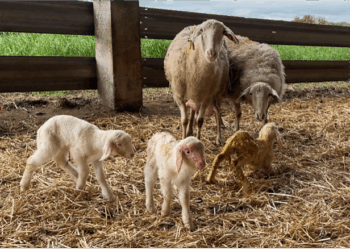Vaccination against Chlamydia is recommended prior to mating, but vaccination at another time is often unavoidable. This may involve vaccination of pregnant animals, and questions may arise as to the safety of the vaccine. A recent study evaluates the safety of the INMEVA® inactivated vaccine, administered to ewes in the last month of pregnancy.
Vaccination against Chlamydia
Ovine enzootic abortion, caused by Chlamydia abortus, is the source of large productive and economic losses on sheep and goat farms.
Vaccination is the most effective way to control abortions caused by Chlamydia
In most cases, vaccination protocols are carried out prior to mating, to ensure maximum protection before lambing/kidding.
However, in practice it is sometimes necessary to carry out emergency vaccinations to deal with outbreaks and this may involve needing to vaccinate during the last month of pregnancy.
In this situation, there may be concern and doubt as to the safety of vaccination.
Inactivated vaccines against Chlamydia are characterised by their strong safety profile
Traditionally, live attenuated vaccines against Chlamydia have been the most widely used, but their safety has been disputed as there have been cases of abortions caused by the vaccine strain. 1,2,3
A recent study aimed to evaluate the safety of INMEVA®, an inactivated vaccine, when administered during the last month of pregnancy.
How was it done?
A total of 57 pregnant ewes were part of the study, divided into five groups in which different protocols were carried out with INMEVA® or phosphate-buffered saline (PBS).
Data were collected on: injection site reactions, systemic and rectal temperatures, and reproductive problems.

Results obtained

The results of the study were very positive. Vaccination, regardless of protocol, did not cause visible local or systemic reactions.
An increase in rectal temperature was observed in all groups 24 hours after vaccination, but it normalised within the following 24 hours in all cases.
Visible local or systemic reactions were not observed in any group
Certain reproductive problems were observed in some groups, but they were not considered related to vaccination, since they were also present in the control groups.

Some ewes in Groups 1 and 4 did not lamb, probably due to fetal resorption in mid-gestation. Therefore, this fact is also not attributable to the vaccine.
Conclusions
We can consider the INMEVA® inactivated vaccine a safe option for emergency use during the last month of pregnancy.
Therefore, vaccination with INMEVA® is a viable strategy to combat outbreaks of abortions in ewes, providing a reliable method to protect flocks even at the end of pregnancy.
Article written by:
Tania Perálvarez Puerta. Global Product Manager, Small Ruminants Franchise – HIPRA
References:
1. Gaston, S., et al. (2020) The 1B vaccine strain of Chlamydia abortus produces placental pathology indistinguishable from a wild type infection. PLOS ONE, Nov 16, 2020.
2. Longbottom D. et al. Genomic evidence that the live Chlamydia abortus vaccine strain 1B is not attenuated and has the potential to cause disease. Vaccine 36 (2018) 3593-3598
3. Laroucou K. et al. Abortion storm induced by the live C. abortus vaccine 1B strain in a vaccinated sheep flock, mimicking a natural wild-type infection. Veterinary Microbiology 225 (2018) 31-33




